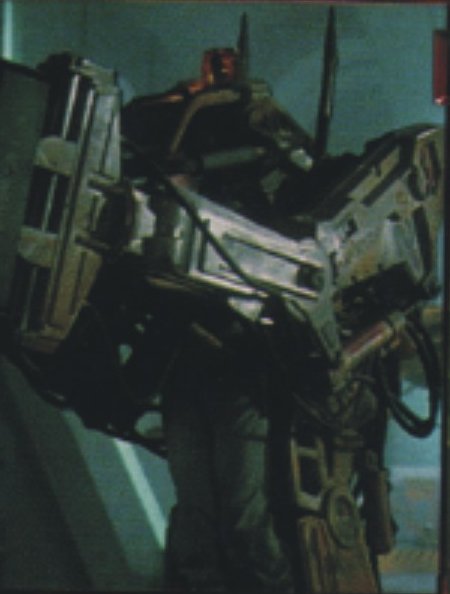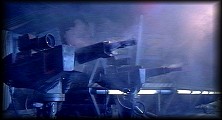M3 Armor



With the devastating firepower now deployed on the modern battlefield, personal protection for the Marine rifleman is essential. The major threats are not just from small-arms fire, but also from artillery blast and fragmentation. Marine combat armor is designed to balance lightness and comfort with optimum protection. The M3 pattern personal armor is based on the French armed forces’ Cuirass de Combat and consists of a sandwich of materials molded to form a rigid shell. The outer layer of the sandwich is an ultra-light titanium aluminide alloy to provide structural strength and ablative protection against lasers. Beneath this is a core, consisting of a layer of boron carbide, is an incredibly hard ceramic designed to shatter a bullet on impact while simultaneously forming a coned bay to absorb its energy. Beneath this, the carbon-fiber layer provides ballistic protection at the point of penetration by delaminating across a large area, so absorbing more energy. Finally, on the inside of the armor is a woven liner made of 1500 denier Venal fibers. This woven liner dissipates the remainder of the energy by deforming in the area of impact, and is also able to catch any spalling or fragmentation from the first three layers. Since any bullet or fragment impact on the armor shell tends to compromise its integrity and ability to provide ballistic protection, it is standard practice to replace any affected sections immediately.
In practice, the stopping power of the armor is somewhat limited versus direct hits, particularly from high velocity ball ammunition and HEAP small-arm rounds. However, it can be expected to stop low-powered ball ammunition and provide some protect against impact-fused explosive bullets and grenade or artillery fragments. Some stealth characteristics have also been included, such as curved and rounded surfaces to reduce radar signatures, and infrared masking.
The M3 armor comes in several pieces. The main component is a rigid vest, which protects thoracic-abdominal region, front-and-back, between the groin and neck. This compromises a two-piece clamshell secured at the sides by plastic clips. At the top of the clamshell, above each shoulder, is a rigid load bearing arch from which hang the webbing straps. The arches are padded beneath to protect the wearer’s shoulders when the armor is loaded with an IMP frame. Two segmented piece attached by webbing straps protect the front and side of the shoulders. Inside the clamshell are remote biomonitors, which measure the wearer’s life signs including heart rate and breathing. An optical cable connects these to the PRC489/4 transmitter in the M10 ballistic helmet.
On the rear left shoulder of the armor vest is a mounting bracket for a high powered halogen white-light TNR lamp. The TNR lamp runs off a rechargeable internal battery and incorporates a carrying handle so that it may be detached and used as a hand torch. Also on the back of the armor are three mounting brackets for and IMP frame. IMP (Individual Marine Pack) is a lightweight medium pack designed to carry up to 24kg; it is attached to a carbon-fiber A-frame which clips onto the rear armor mount. The pack is water repellent but not waterproof, though waterproof liners are issued for each of the main compartments and pockets.
Below the armor vest is a separate section, which covers the front abdomen and groin. This is a flexible pad of Rheological ballistic armor secured by a ‘diaper’ harness. A rigid armor plate is fixed to the lowest part of the pad to protect the genitals.
Leg armor consist of a pair of clamshell greaves which cover the whole of the lower leg from ankle to knee. The knee segments are articulated on webbing straps and are tied around the leg above and at the back.
M10 Helmet
Head protection is provided by the M10 pattern ballistic helmet, which incorporates a tactical camera, audio microphone, IFF transmitter and a PRC489/4 receiver/transmitter system. In addition, the helmet also mounts a passive infrared sight, which flips down over the right eye. This projects IR images form the thermal imaging facility built into the tactical camera, superimposing them over the background as in a Heads Up Display


Grenades

M38 High Explosive Armor Piercing (HEAP) round.
Capable of penetrating 7cm of homogeneous steel, the round bursts with a casualty radius of 5m. This round is marked with a green cap.
M51a Bounding Fragmentation round.
This blue-capped round is not point detonating like the M40 or M38. When the round impacts, a small charge propelled it two meters into the air, where it air bursts for additional effect against troops in the open or in foxholes without overhead cover.
M60 White Phosphorous Incendiary round.
This white-capped round contains a filler of white phosphorous which spreads up to 15 meters after impact, creating a rising smoke cloud and flame with a secondary incendiary effect against vegetation and material.
CATERPILLAR P-5000 POWERLOADER
  |
The Caterpillar P-5000 Powered Work Loader has been selected by the USCM as their prime loader vehicle for logistics and support operations. Configured as an anthromorthic exoskelatal power frame, the P-5000 offers unprecedented flexibility when handling 0=ordinance and cargo during rough field operations or when conducting heavy maintenance away from fixed workshops. Capable of fine manipulation loads up to 4,000kg, the P-5000 is a rugged and reliable alternative to conventional forklifts,rigs and cranes. Th chassis of a P-5000 is a reinforced steel framework with two upper load bearing points for the arms. |
A hydrogen fuel cell is mounted on the back of the frame, providing up to 65kw of power for the loader. The articulated legs are attached by two semi-universal bearings to either side of the chassis, allowing up to 60 of 'x' axis (hip swivel) movement; just below these are a set of knee bearings. Leg motions at the hip are controlled by a pair of 20kw linear motors actuated via a fast-feedback loop slaved to the operator's movements. Below the hip, hydraulic actuators extend form the main load-bearing points to the aft sections of the legs,providing 'z' axis (fore/aft) movement at the knee joints, while pitch control is handled by a second series of actuators at the ankles. To prevent toppling while stationary and under load, the chassis is gyrostabilizer . These gyros can be rotated rapidly out of phase in order to 'decouple' the chassis stabilization system along determined axis of motion and provide the necessary instability required for bipedal movement . For very heavy lifting work, additional stability can be provided by bolting up to 250kg of concrete ballast to the underside of the chassis.
Motion Tracker
The motion tracker is a simple (but effective) surveillance device originally designed for use by rescue and police services. Essentially, it is a high-powered ultrasound scanner that uses Doppler-shift discrimination to filter out moving object from the stationary background.
A moving object is shown on the tracker's display as a series of contours of probable loci, with the range and bearing given to the target. Motion trackers are often employed for perimeter surveillance, able to monitor movements of small animal-sized targets up to a range of 1000m in open country. The greatest advantage of the motion tracker is its ability to scan through objects; however , intervening terrain can cut this detection range quite drastically, and in built-up areas the presence of walls and partitions can reduce the range to less than 20m.
Motion tracker operations must become familiar with their limitations. First, they are active sensors, emitting thousands of high energy ultrasound bursts every second, and can be easily located by enemy listening stations to serve as a target for enemy fire. Secondly, the tracker range fate function is calibrated to reject small or slight movements ( such as bugs crawling, plants waving in the wind etc.), so that very slow-moving objects can infiltrate a tracker's detection cone( as guerrillas did on many occasions during the Arcturan War). Thirdly, trackers are vulnerable to spoofing by ultrasound jammers, or 'jumping jack' decoy devices. as a result , most commanders prefer motion to supplement other surveillance techniques.
 Motion tracker display
Motion tracker display
UA 571-C REMOTE SENTRY WEAPONS SYSTEM


 remote terminal display
remote terminal display
The UA 571-c is a man-portable automatic perimeter defense system currently deployed in the field. A remote sentry unit weighs in at 19.6kg and can be assembled in under 150 seconds. The major components consist of a snap-open tripod mounting, battery pack, breech and barrel assembly, sensor unit and 500 round ammunition drum. A microwave datalink connects the sentry to a remote command console. Once emplace, the system may be set to sweep wide arcs up to 360 degrees (subject to terrain and emplacement restrictions), though doctrine is to set several sentries to cover smaller, interlocking fields of fire on a narrow frontage. The UA 571-C mounts a pulse action machine gun, using the M250 10 mm x 28 HEAP round. The weapon has a cyclic rate of 1100 rmp and is air cooled, with an automatic cutout preventing the loading of any more rounds into the breech should overheating cause a chance of ammunition 'cook-off'.
The sentry unit's sensor array is mounted above the barrel, aligned to cover a 60 degree cone in front of the weapon. This sensing suite consists of a cooled infrared detector in the 3-5 um and 8-13 um band, ambient light optics, an ultrasonic motion tracker and a lidar. It a target;s visual or thermal profile is known, the system may be set just to monitor these specific targets using infrared or optical. However, the system is usually set to multi-spectral mode, where the sentry's software cross-correlates received data from the different sensors to obtain a full target profile.
If the sentry is set to 'auto remote', it will interrogate all targets in its sensor cone, using an Identification Friend For (IFF) transponder. All Colonial Marine personnel and vehicles carry an IFF transponder in their communications gear which sends back a coded radio signal when interrogated. If the IFF return is positive, the weapon will let the soldier or vehicle pass; otherwise it will open fire. If the system is set to 'manual override' or 'semi automatic', this information is flashed back to the command console, where the system operator can decide whether or not to fire.
When the weapon fires, automatic servos in the tripod boresight the weapon on the target. The number and grouping of rounds fired in a burst is dependent on the target profile, so that the most economical use of ammunition is made.
The US 571-C is one of a family of remote sentry systems including the -D variant, which mounts a 20 mW HF laser, and the -F version, which employs a 40 mm automatic grenade launcher.
